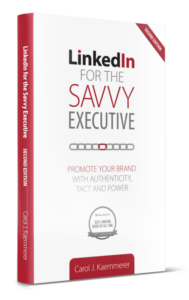
Why Are You Playing Small on LinkedIn?
Why Are You Playing Small on LinkedIn?
You don’t play small in person. You have an executive presence in any room, including all the virtual rooms in which we’re doing business these days. You dress for effect. You are careful to ensure that your grooming is on-brand. You command attention when you speak. You’ve seen to it that your LinkedIn profile is one of first entries that appears on a Google search of your name.
So, executives, why are you “playing small” on LinkedIn? LinkedIn is THE business place where people look to see what you’re about. If on the one platform where countless people are making their first impressions of you every day, your profile and presence fail to reflect your eminence then you are failing to attract the talent you wish to hire. You are not managing your career trajectory and maybe actually repelling opportunities that might otherwise find you. If poorly managed, your online presence might actually damage your overall credibility and influence.
Below I’ve spotlighted some of the ways executives tend to “play small” on LinkedIn. Read more to see if any of these cases apply to you – and if so, how to address them.
Failure to package your profile with flair:
Executive presence is a phenomenon embodying poise, confidence, and professionalism, blended with charisma or a “wow” factor. The wow factor on a LinkedIn profile is most often conveyed visually, through your portrait, your banner image (the real estate that is behind your portrait that is various shades of gray-green if you haven’t customized it), and your Featured section.
Let’s start with your portrait. Chapter 3 of my new book, LinkedIn for the Savvy Executive-Second Edition, has an excellent checklist that can help you decide whether you need a new photo. It should look like the best version of you, NOW (not the way you looked ten years ago. If you use a photo that shows you with a healthy head of hair but you are now bald, that deceit will undermine the credibility of all your profile.). You should be wearing your best smile or most approachable expression. You should be looking directly at the camera lens, and you should be dressed appropriately as if you are about to meet with an important new prospect or make a presentation to your board. Chapter 3 also has guidance on choosing a headshot photographer who will create an executive-quality image that matches your own version of executive presence.
Your banner image should definitely be customized, and not the default banner provided by LinkedIn (e.g., currently a non-descript field of three colors of green). Perhaps it could showcase your company logo or provide an image that evokes some aspect of your business or personal brand. Customizing your banner makes a huge difference.
The lack of a Featured Section in your profile is also a sign of playing small. This is a new, visually powerful section for photos, graphics, or videos. Check out my article on the Featured section to help you enhance your online brand by providing visual appeal.
Failure to establish know, like, and trust:
Chapter 5 of my book addresses all sections of an executive-branded LinkedIn profile. Although every section contributes to your brand, the headline (the text right below your name) and the About section can be the most instrumental in establishing your know-like-and-trust factor – a factor that must be present before someone will be interested in doing business with you. (People do business with people that they feel they know, like, and trust).
Your headline is auto-filled by default with your current position and company, but you can replace that default, customizing your headline with up to 220 characters of text. Tell those looking at your profile something more than your title. Tell them who you serve and how you add value; tell them about your leadership style; tell them about your results. Remember, you want to give people a reason to know, like, and trust you.
Your About section should be about YOU — not about what you DO, but who you ARE. Share something that helps people know you. This section can touch on your current role, but really that’s what the text you provide under your current position should be about. Instead, here you have about 4 to 5 paragraphs in the About section (2,600 characters) to tell your professional story. “When what you share is authentic, you connect emotionally with your reader. The more transparent and authentic your profile, the more people will feel they can know, like and trust you even before they meet you in person.” (page 59). What are your business principles, what is your career purpose, what are your passions? Share those. Why? When you share only what you DO, the content could apply to nearly all your competitors. When you share who you ARE, no one else can claim that.
Failure to use logos:
The absence of a logo on your LinkedIn profile is always a negative, but it is most damaging if the missing logo is for your current role in a company for which you are among the top executives (e.g., Owner, Founder, President, CEO, Principal Consultant, etc.). For example, if you are the founder of a company but your LinkedIn profile shows no associated company logo, it may be interpreted that you have a hobby rather than a real business – that you are not serious about your endeavor. Simply put, this error is a primary way senior executives undermine their own credibility. But if you have made this error, it is totally within your power to fix it. Read my article for remedies to this type of missing logo problem as well as several others.
Failure to engage on the LinkedIn platform:
LinkedIn is a great way to share your thought leadership, expand your influence, and nurture relationships that are important to your business success. If you’re not engaging on the LinkedIn platform, you are missing opportunities.
So, stop playing small on LinkedIn:
You have so much to contribute, and so much to gain by showcasing your eminence on your profile and cultivating relationships online. LinkedIn is an essential business tool today. Use it well and thrive.
If you are a C-Suite executive or senior leader who would like to improve your LinkedIn profile and presence, I can make it easy for you. I have a track record of working effectively with C-Suite executives and senior leaders to create LinkedIn profiles and other executive-branded materials that help them show up as authentically and powerfully online as they do in person. This way, they can attract the talent they want to hire, increase their visibility and influence, and control their career. I also mentor clients on LinkedIn etiquette and effective posting strategies to ensure their success. Let me help you use this essential business tool effectively. Contact me through my website: www.carolkaemmerer.com or profile: www.linkedin.com/in/carolkaemmerer.
Other resources for you and your team:
For a virtual or in-person presentation on personal branding via LinkedIn, contact me. I am a member of the National Speakers Association, a

Certified Virtual Presenter, and an Advisor to the C-Suite Network.
My NEW book Second Edition: LinkedIn for the Savvy Executive: Promote Your Brand with Authenticity, Tact and Power is available through online booksellers. For quantity discount or signed copies, contact me directly.
To receive my monthly articles in your email inbox, sign up for my monthly emailing here.
A member of National Speakers Association and certified as a Virtual Presenter, Carol is also an Advisor to the C-Suite Network.
- When Staying Isn’t an Option: Preparing for the Unexpected - December 22, 2024
- The #1 Brand-Buster for Coaches and Entrepreneurs on LinkedIn (And How to Fix It) - December 3, 2024
- The Competitive Edge: Why Senior Leaders’ LinkedIn Profiles Matter More Than Ever - November 7, 2024



 (1)-66d0b3db9ed74.jpg)


